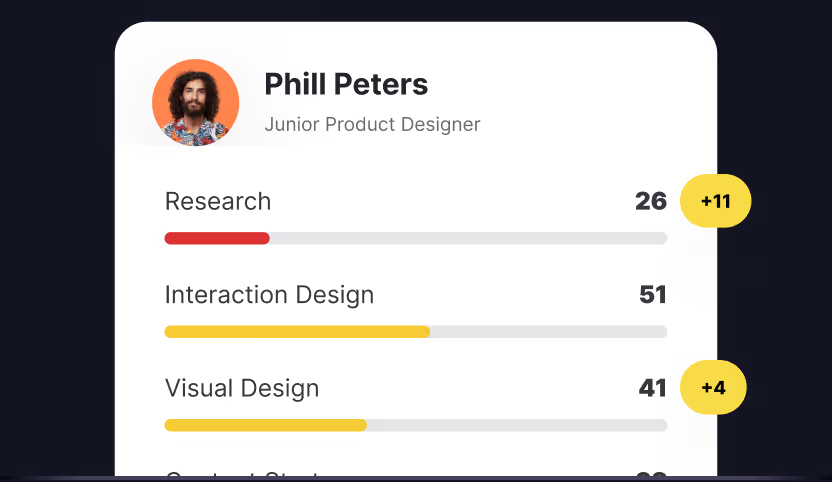
You've polished your design resume, applied for a few UX design job positions, and finally got invited for an interview. What next? UX designer interviews can be quite intimidating, especially if it's your first design job or you're transitioning to UX design from another field. By discovering what questions a hiring manager may ask you and understanding the structure of the UX design interview process, you'll feel less nervous when entering the interview room. Nail your next interview with these 16 UX interview questions and answers, and take the next step by exploring UX design jobs and other design-related positions on UX job boards.
Most Common UX Design Interview Questions
1. Tell us about yourself

Alternative forms of this question:
- Tell us your UX story
- Why are you interested in UX design?
- Tell us a little about your background
This is probably the most common question to begin the job interview — it is your chance to give a glimpse into your background. However, avoid getting off track — talking about your favorite school subjects, movies, or hobbies is not what's relevant here.
The interviewer wants to hear about how you entered the UX design field, what or who sparked your interest, and how you started your journey in UX design. Tell them about how you discovered your passion and what steps you have already taken to succeed in your UX career.
If it's your first UX designer job and you don't have any prior experience, think of the soft skills you have that make you perfect for the position and company culture. For example, by mentioning problem-solving skills, curiosity, communication skills, and empathy, you demonstrate that you know how to handle negative feedback, work in a team, and enjoy exploring customer behavior.
2. What are your biggest strengths and weaknesses?
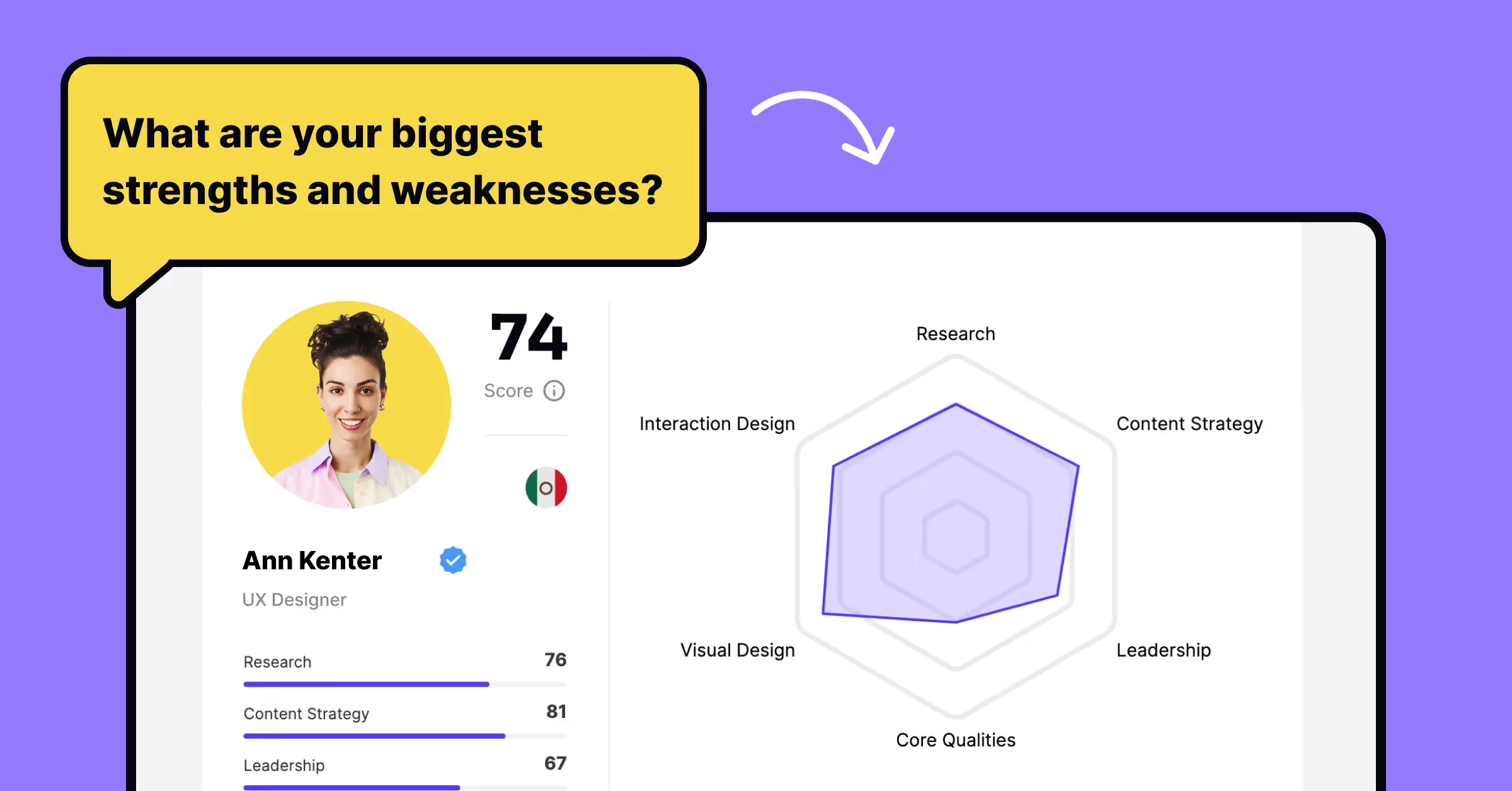
Alternative forms of this question:
- What are your strong/weak sides?
- What makes you perfect for a UX designer position?
To answer this type of UX designer interview questions, review a company's job description. What kind of UX designer are they looking for? For example, if they expect a UX designer to create user-centered, intuitive, and delightful interfaces, empathy is a strength worth mentioning. If they expect a candidate to be proactive and participate in cross-functional discussions and design workshops, talk about your leadership and communication skills.
When discussing your weaknesses, frame your answers so those weaknesses seem positive from a company's perspective. For example, the job description mentions a fast-paced startup environment. For candidates, it means you should expect constant changes and challenges and be ready to implement various tasks, sometimes unrelated to UX. Say you might get bored without being challenged or need a regular change of tasks to stay productive when answering this question.
3. Where do you see yourself in five years?
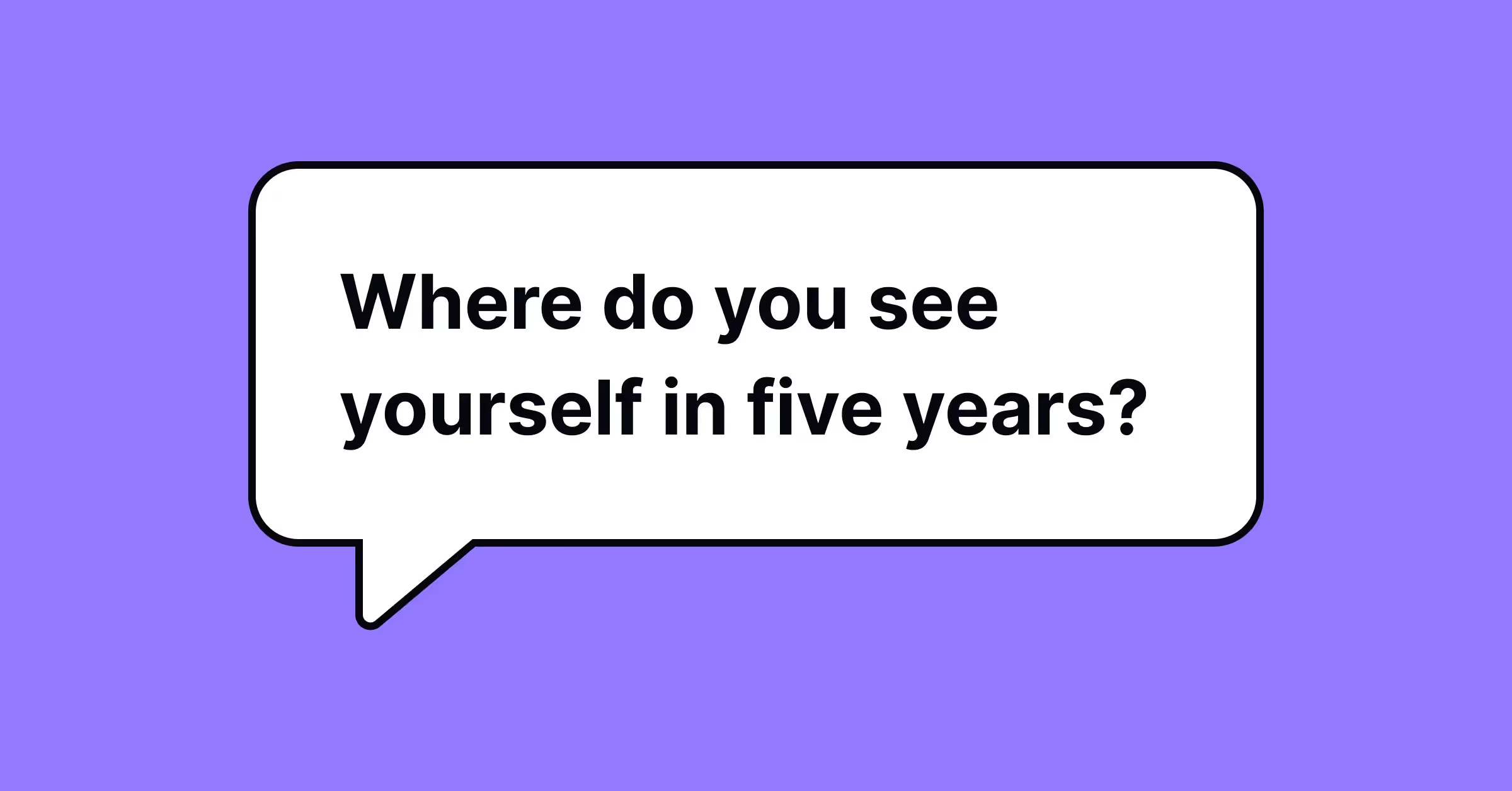
Alternative forms of this question:
- How do you see your UX design career?
- What are your professional plans?
This is a long-term question, and you might not have a clear plan. Your employer wants to hear that your interest in the field of UX design is not just a fling.
Provide an overview of your UX designer career goals and describe the steps you plan to take to achieve them. If you want to dive deep into one particular field or become a UX lead and have enrolled in relevant UX design courses or are getting a college degree, you should mention that.
4. How do you define UX?

Alternative forms of this question:
- What’s the value of UX design?
- What is UX and UX design?
- What's the difference between UX and UI design?
The question seems simple enough, but it's about more than just a textbook definition. The hiring manager wants to know if you understand what UX is about and whether you know how to apply your UX design skills.
Explain UX design by focusing on empathy and a user-centered approach and show your knowledge of the UX design process. It's less about sounding smart and more about your understanding of UX presented in simple yet impactful words. For example, you can define UX design as the process of designing products or services with users' interests and needs at heart. Continue by bringing up the value of user research, the design thinking approach, and what this concept embodies.
Show potential employers your design process knowledge by answering common interview questions — practice with Uxcel's Interview Skills challenge.
5. Describe a recent challenge and how you approached the problem

Alternative forms of this question:
- Tell me about a time when something went wrong
- How do you face challenges?
- How do you handle stressful situations?
When answering this type of question, be honest and don't exaggerate your role. Your experience and enthusiasm will speak volumes to your benefit.
A well-rounded design team is essential for any design-driven company. When interviewing and looking to hire UX designers, it's important not to overlook the right candidate. But it is even more important not to hire a bad fit. Download the 12 example interview questions guide you might consider asking a design candidate, what to look for in their answers, and how to choose the right fit.
Explain what was unique about this challenging project, what steps you and your team took to achieve the end goal, and what insights you gained from this experience. Don't forget to mention all techniques and research methods you used, including user personas, user interviews, surveys, task analysis, or anything contributing to the final solution.
If you don't have job experience, talk about a design project you've been working on in college, taking UX design courses, or helping a friend's startup. If it's your first job interview for a UX design career and you're transitioning from another unrelated industry, talk about challenges at your last position that might showcase your best qualities relevant to this job.
6. What's your design workflow?
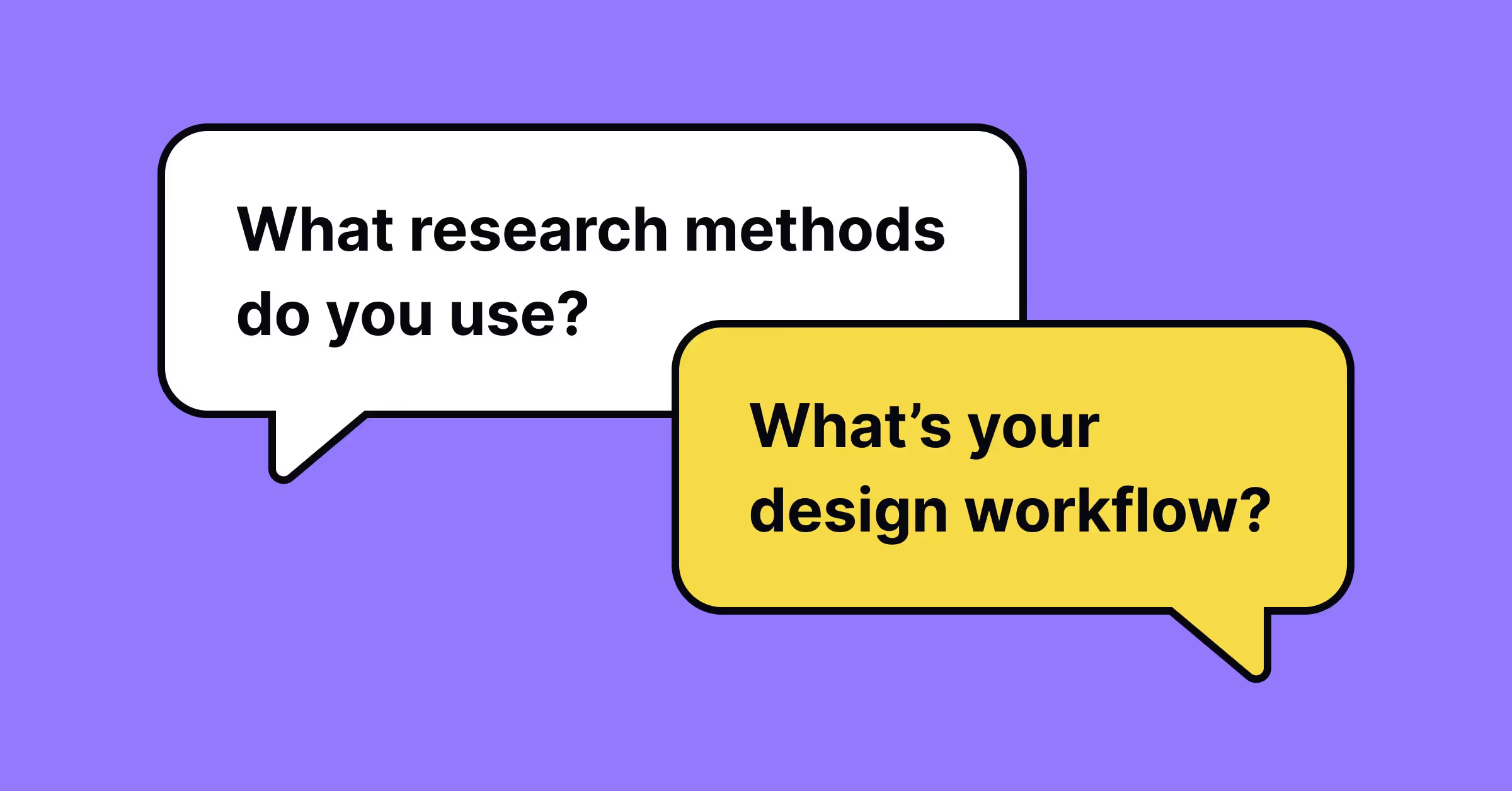
Alternative forms of this question:
- Guide us through your design process
- Describe common UX designer responsibilities
- How do you decide which research method to use?
Different designers use different UX approaches. Answering the question about your design process, walk the interviewer through the steps you usually take when starting a new project.
Take a past favorite project as an example, and don't hesitate to go into detail about the background, roadblocks, limits encountered, and concepts and methods you used. Other important things to mention are competitive and content audits, empathy maps, surveys, user personas, interviews, customer journeys, sketches, and prototypes. Above all, if you follow any heuristics, design standards, or best practices and have ever conducted a UX evaluation, bring it up.
Even if you only have hand-drawn sketches or low-fidelity wireframes, include them in your UX design portfolio. What matters to employers is not aesthetically perfect visual design but your thought process and your skills in planning user research, designing flows and screens, and conducting usability testing. Demonstrate your understanding of finding the balance between business goals and users' needs.
7. What is the process of a design handoff?

Alternative forms of this question:
- How do you collaborate with developers?
- How do UX designers interact with other team roles?
This interview question is meant to check your communication skills. A successful handoff implies regular discussions and design reviews that involve developers and encourage them to share their ideas and give their feedback.
Assets like user flows, prototypes, animations, and design systems are also worth mentioning at this point in the UX designer interview. User flows and prototypes help developers understand user needs better, visualize all interactions, and identify common goals. Including animations prevents misunderstanding and helps developers understand how final animations are intended to look. Design systems help establish a common language between UX designers, UI designers, and developers, organize work, and help keep things consistent.
8. How do you cooperate with other teammates?

Alternative forms of this question:
- Describe your ideal work environment
- How well do you work in UX teams?
This question revolves around your ability to be a team player and your willingness to adjust and be open to feedback. Ultimately, team spirit and collaboration are key attributes of a good UX designer.
When answering this question, demonstrate your enthusiasm to empathize and the ability to put yourself in other people's shoes and understand their perspectives. Provide a few real-life examples of how you found a way to communicate with other UX or UI designers, UX leads, developers, business analysts, or project managers.
9. What are your favorite websites and apps for UX? Why?
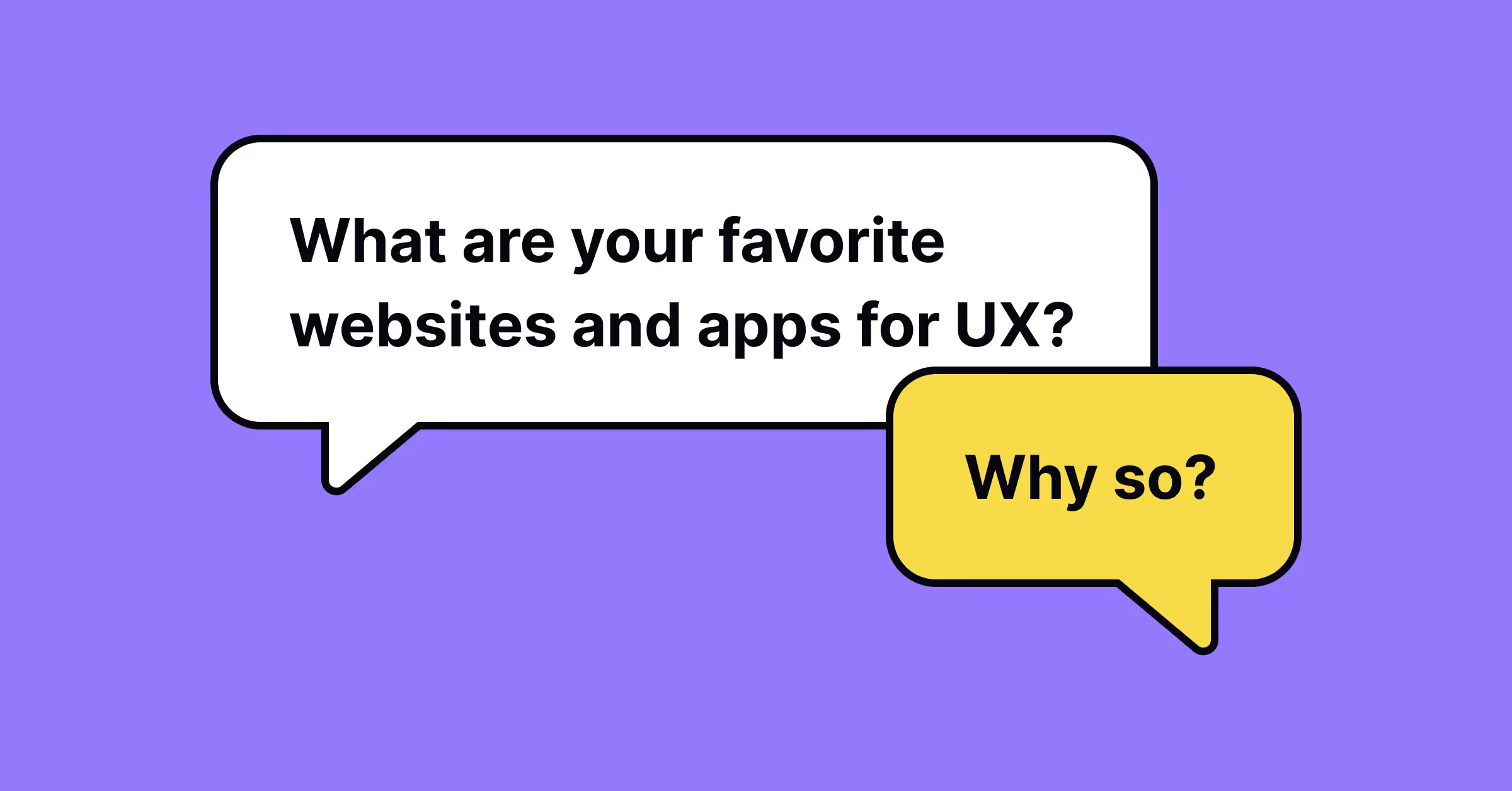
Alternative forms of this question:
- What is good UX for you?
- What does it mean to have good UX?
As you know, good design is not just about achieving good visual aesthetics but also meeting your users' needs. To tackle this question, think of products that provide a truly delightful user experience overall.
Talk of your favorite apps and websites, and especially their aspects that demonstrate good UX. For example, you can mention Spotify and talk about their amazing personalized content or describe how Duolingo uses gamification to encourage users to learn new languages.
10. Tell us about the project you're most proud of?
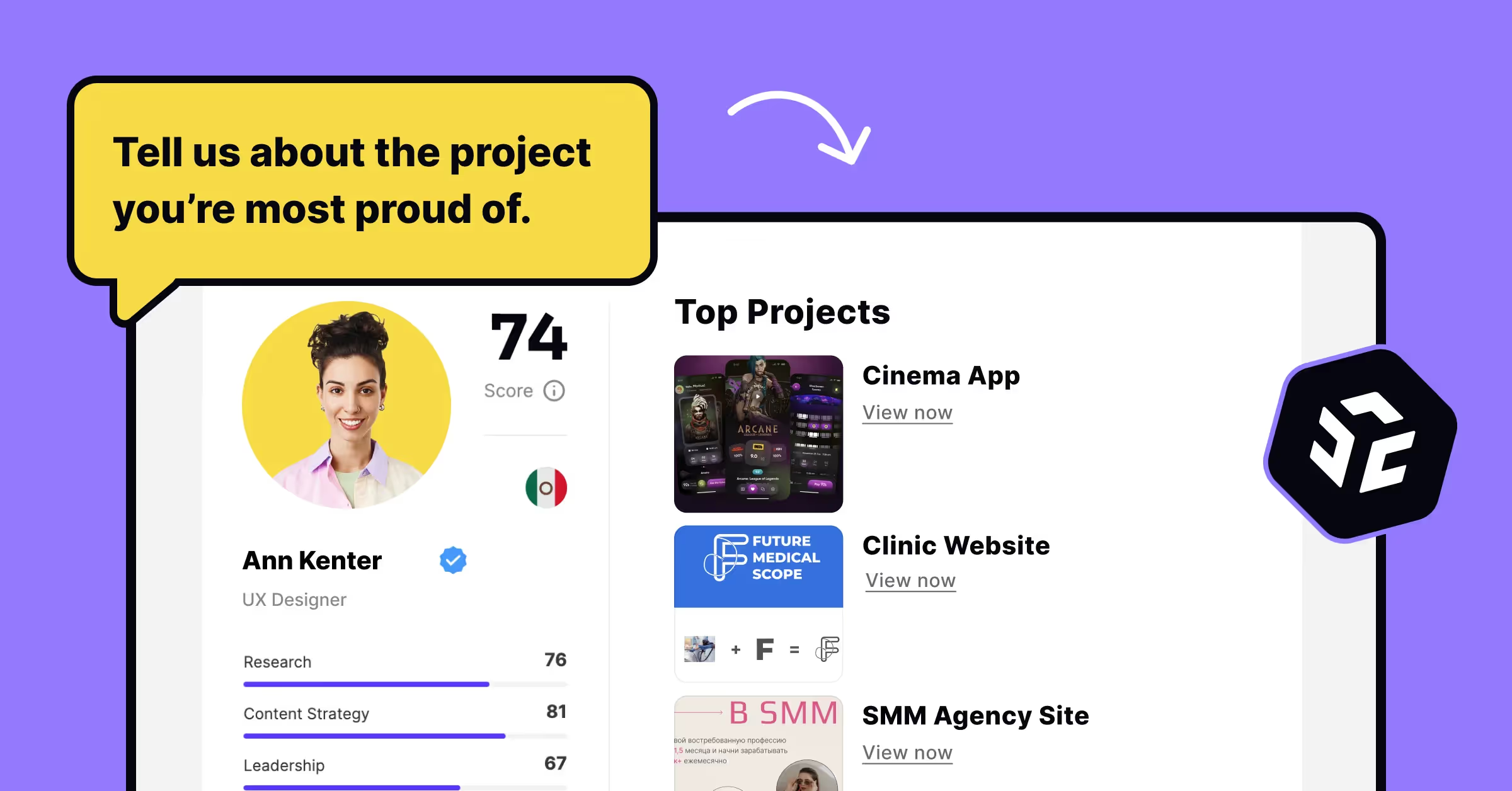
Alternative forms of this question:
- Walk me through your UX portfolio
- What's your experience as a UX designer
If you've been waiting for an interview question that allows you to brag a little and show off your UX design work, this is it. Describe a successful project that helped you fully exploit your strengths, hold more than one role, or maybe dragged you out of your comfort zone.
Don't forget to mention your contributions to the final product — it could be growing your product's user base or improving your app's rating on the AppStore. Did you face any setbacks? Describe how you managed to overcome them and what you learned from them. Answering this interview question, you can mention prototyping tools and visual design software that you've used in your design process.
11. Tell us about a time when you disagreed with your teammates. What did you do?
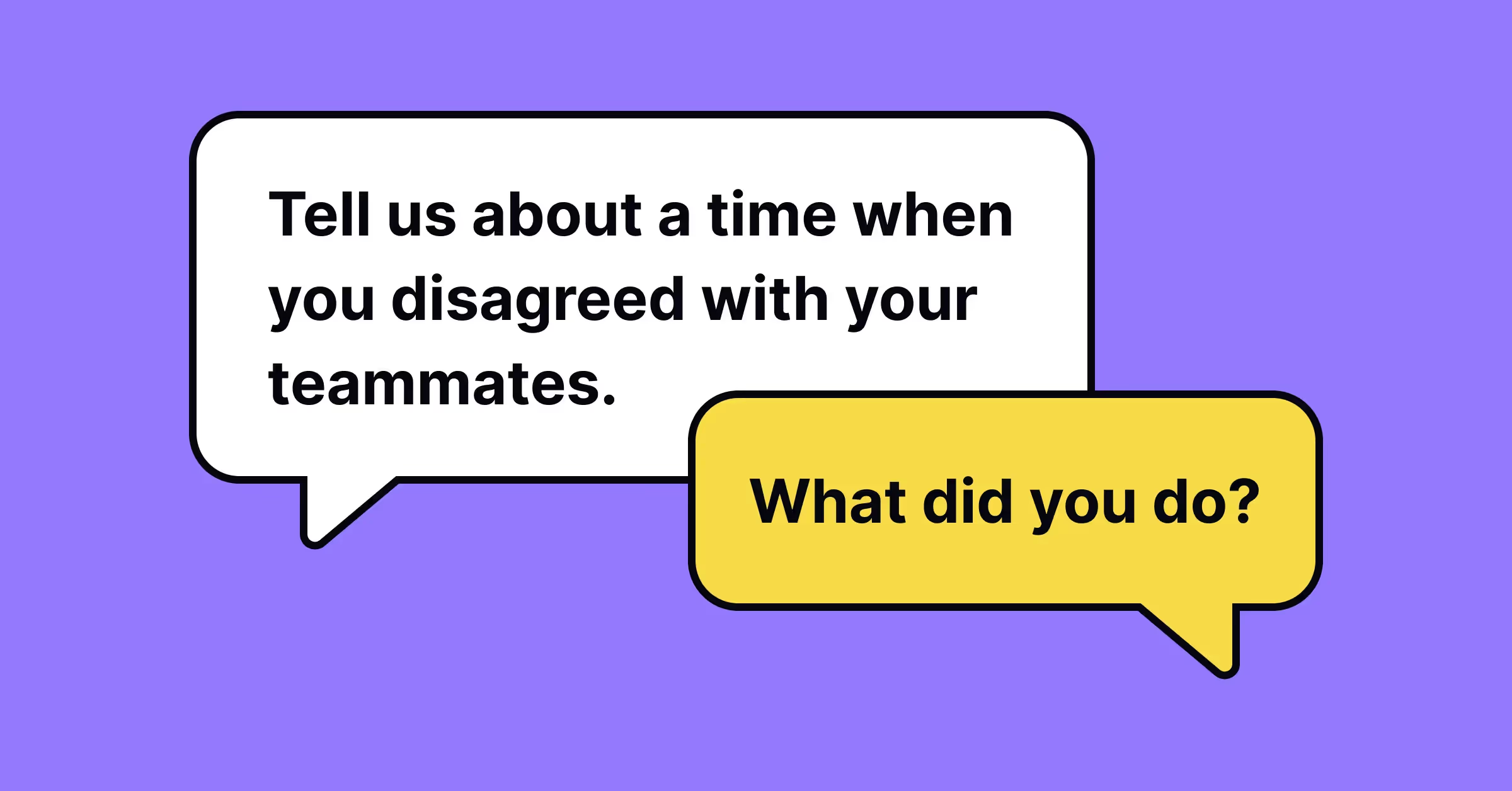
Alternative forms of this question:
- How do you handle conflict situations in a team?
- How do you react to criticism?
Confirming that you had disagreements in a design team doesn't put you in a bad light. On the contrary, disagreement is an essential part of the design process, and the way you handle it demonstrates your ability to face criticism and accept others' points of view.
For example, you can describe a case when a project manager's recommendations were subjective, and you found valid arguments to prove them wrong. You can describe a situation when you received negative feedback from a UX lead at your previous job and explain how you handled it and what this experience taught you.
12. What would you improve about the UX of our product?
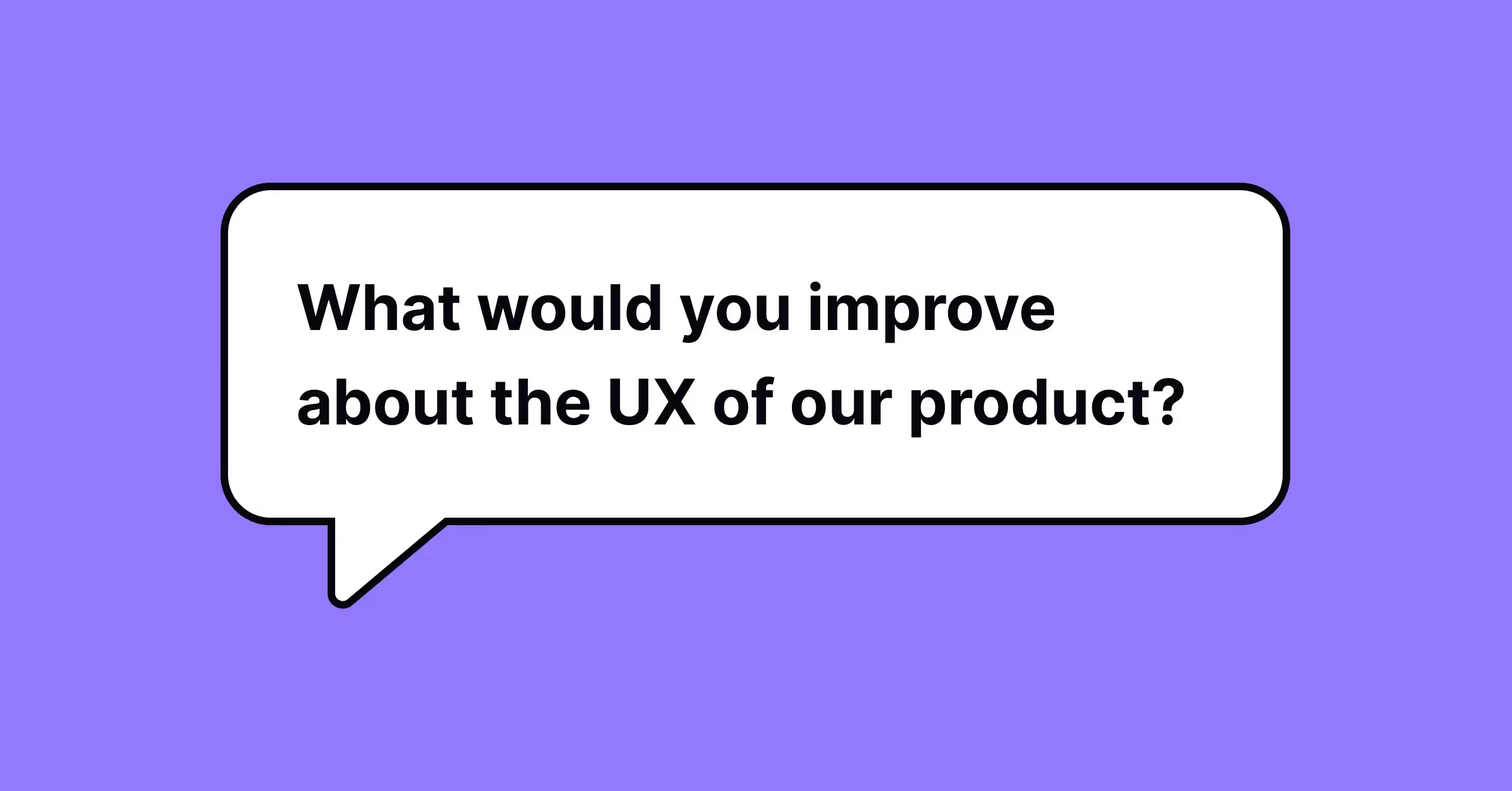
Alternative forms of this question:
- Tell us about a bad user experience with a product you’ve had. How would you fix it?
- What are the elements of good UX?
By asking this question during a UX designer interview, recruiters want to check whether you've done your homework and explored a company's product or service. Take some time to test a website or an application and think of one or two things that can be improved. Guide interviewers into your thought process and explain what steps you would take to fix things. Ask them about their target audience and describe what user research methods you might employ to understand users' pain points.
Avoid using accusatory or offensive statements — after all, you might end up working with people who implemented this design. Being polite in delivering criticism demonstrates your communication skills and gives interviewers an idea of how you would talk to stakeholders.
13. What excites you about this position?
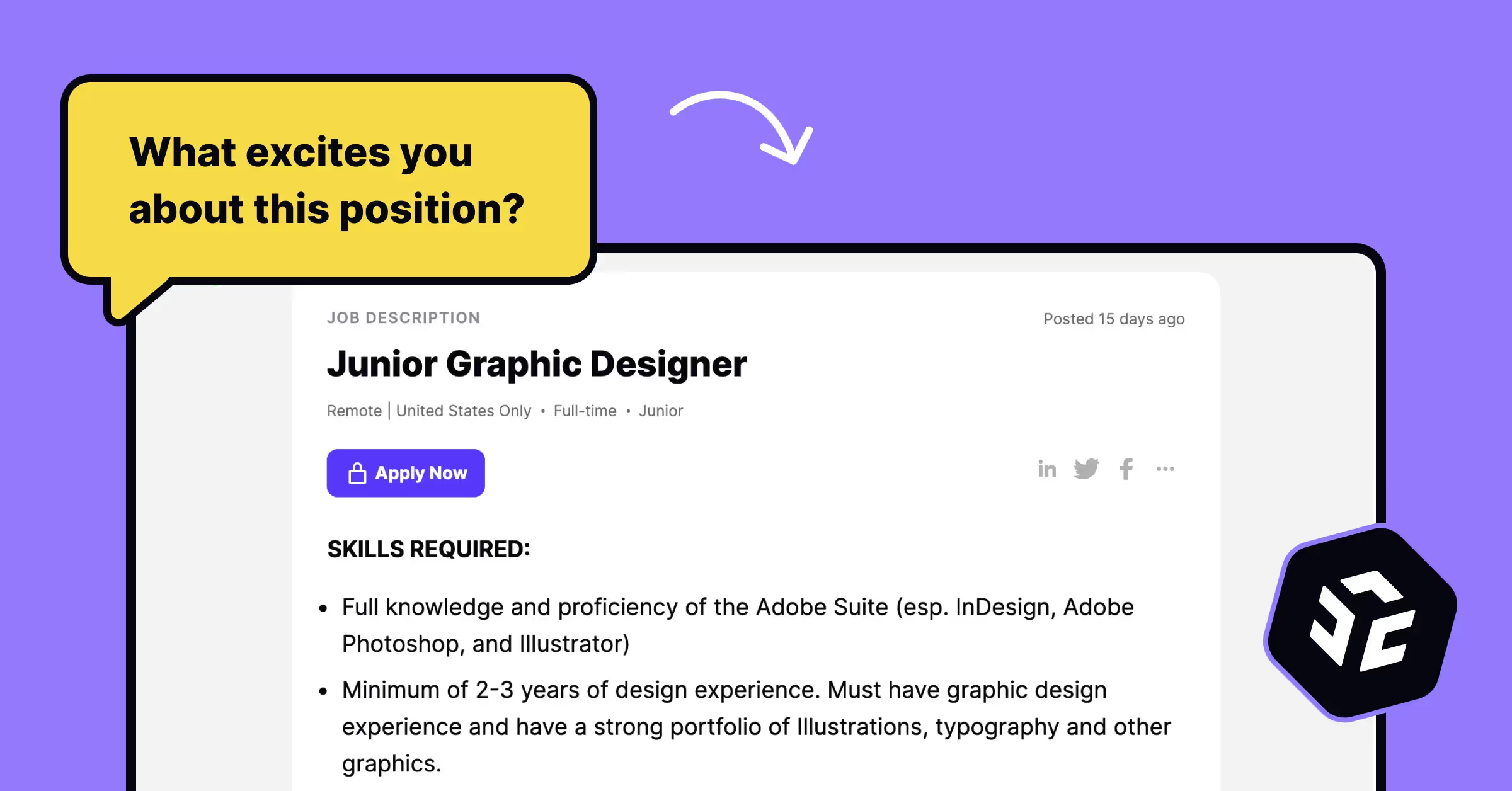
Alternative forms of this question:
- Why did you apply for this position?
- Why do you want to become a UX designer?
This is a trick question to check whether you researched the company's products and read their job description. Spend some time and explore the company's website and apps, if they have any, and think of values you can bring in.
Remember that honesty is the best policy. Talk about what you genuinely like about the position of a UX designer — it can be the company's culture, people, design challenges, or professional prospects.
A great way to stand out and "warm up" the interviewer even before the interview — is a video introduction of yourself. With Uxcel's free designer profile, you can record a Video intro so that anyone looking at your professional designer profile can understand you better even before connecting on the call.
14. Where do you go for inspiration?

Alternative forms of this question:
- What do you do when you feel stuck in the design process?
- What is your design workflow?
- What inspires your work?
UX design is a constantly evolving industry, and being a successful designer means staying in the loop of UX design trends. Before the interview, prepare a list of your UX design inspiration sources so you can show the employer you're keeping up with the industry. Include blogs, books, magazines, podcasts, YouTube channels, and UX design gurus that you follow on Twitter.
You don't need dozens of resources — select your favorite and describe what's remarkable about them or how they help you in your work as a UX designer.
15. The whiteboard task
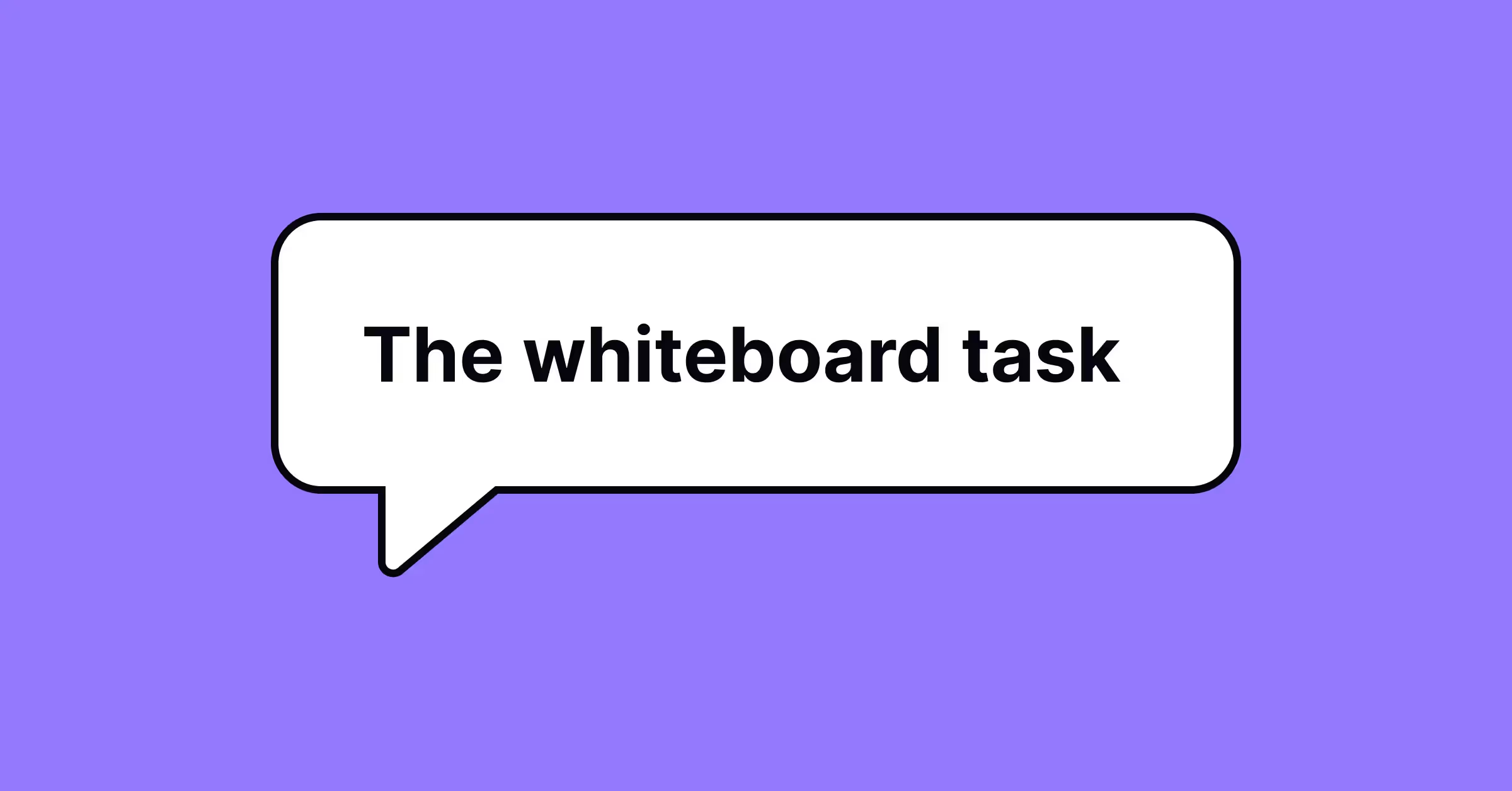
Many employers prefer giving UX designer candidates a hands-on design challenge in real time instead of giving them a take-home project. It allows employers to see how UX designers can work under pressure and how well they operate their skills in practice.
During a whiteboard challenge, a UX designer is asked to develop a solution on the spot and demonstrate their way of thinking. Try not to panic — no one expects you to create a genius solution in 10 minutes. Your goal is to show your UX design process and create the impression that you know what you're doing:
- Ask questions about end-users and their needs, goals, pain points, beliefs, motivations, and background
- Create a user story to outline what steps users may take to achieve their goals
- Sketch a few wireframes on a whiteboard to demonstrate what features may help users solve their problems
- Be open to discussion and be flexible to come up with some alternative solutions
16. Do you have any questions?

This is a common interview question, not just a UX design interview question. The main point is that you have to ask something. It demonstrates your interest, engagement, and curiosity. It proves that you investigated the company before the interview and are excited to work for them as a UX designer.
You can ask them to talk about the company culture or describe an ideal UX designer from their perspective. Do you have some concerns regarding working remotely? That also works. The main recommendation is to be engaged and participate in the discussion. A UX design interview is supposed to be beneficial for both sides — you want to find out about a company and position as much as they want to get to know you better.




